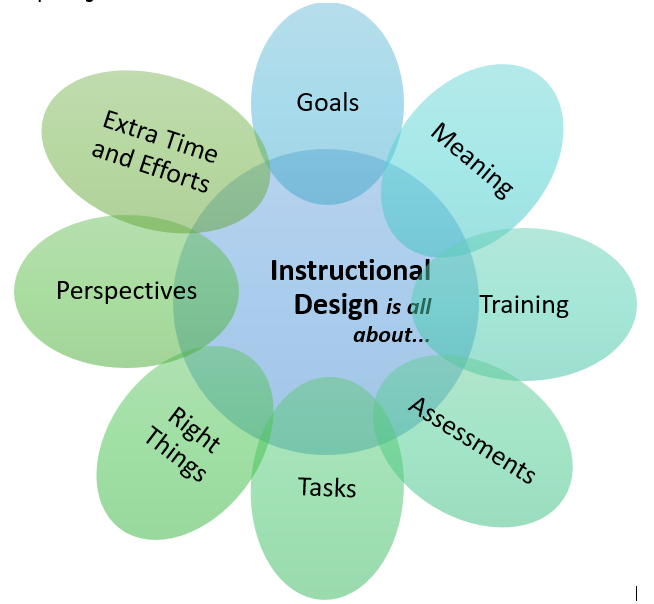The essence of Instructional Design
It is hard to imagine this life without an educational process. People have to study and learn new information to know how to behave, interact, make decisions, and take any other activities that may predetermine the quality of their lives. As a rule, it is expected that any educational process should have a list of instructions to be followed. People should be provided in the right way, an appropriate destination in case they do not know where they should go or why they should do something (Piskurich, 2015). Instructional design is one of the practices that may be offered to learners to understand their needs and choose the methods of a learning process.
Instructional design is used to develop and introduce various tasks and training materials, create helpful manuals and assessment tools that can be used by learners and educators. However, Rothwell and Kazanas (2011) underline the possibility to interpret instructional design not only as a field of practice but also as a thoughtful method of creating training that is called the instructional systems design process. Anyway, it is possible to say that an instructional designer takes responsibility for the enhancement of the instructions with the help of multimedia and the current technological progress and the translation of pedagogical research in the curriculums that are understandable for ordinary learners and can be used and shared under different conditions.
Instructional Design since World War II
World War II was a significant period in the development of the sphere of instructional design. It was necessary to introduce as many military manuals as possible in a short period and describe the peculiarities of human behavior alongside the main learning principles. Military training was a core of instructional design during World War II.
After World War II was over, the idea of instructional design left, and several psychologists wanted to view the idea of training as a possibility to create a system and encourage analysis as one of the main educational processes (Information Resources Management Association, 2011). Social, political, economic, and cultural environments underwent considerable shifts since World War II and led to the changes and challenges connected with the field of instructional design.
It was necessary to take significant steps and promote modifications. In the middle of the 1950s, Skinner introduced teaching machines and set the instructional frames with the help of which it was possible to grasp a lot of new material in a short period (Richey, Klein, & Tracey, 2010). During the next several decades, many different instructional design models were offered by different researchers to prove the importance of various aspects of the training process.
The latest improvements are based on the development of online learning and the evaluation of the technological opportunities that became available to people (Larson & Lockee, 2013). Since World War II, instruction design has become one of the most crucial practices with the help of which people could study and understand what is expected of them at a particular stage.
Contribution Factors
In addition to the fact that instructional design is an important aspect of any educational process, it is necessary to consider the presence of other factors that contributed to the development of the field. The current technological progress and the development of web activities are probably one of the evident and significant contributions that should be mentioned. People get an opportunity to share information in a short period and use as many sources as possible at the same time to meet their personal, educational, and professional needs. Still, not all people know how to use technologies. They need clear guides.
Therefore, it is possible to consider the Internet and the lack of knowledge as two main contributors to the necessity of instructional design. Besides, people’s attitudes to an educational process has been dramatically changed. It is not enough for people to study. They want to combine it with some entertaining elements and the satisfaction of personal needs.
Instructional Design in Various Professional Settings
Career development helps people identify their professional and personal goals, their strengths and weaknesses, and their abilities to cope with new tasks and assessments (Rothwell, Benscoter, King, & King, 2015). The peculiar feature of instructional design is the possibility to use it in various professional settings. First, it is possible to use it in the sphere of pedagogy and provide learners with informative guides. Second, instructional design as a training means can be used in business, management, and economics to provide people with simulators and schemes according to which they can work.
Finally, instructional design can be used as the possibility to evaluate personal needs and abilities; therefore, from this perspective, it can be used in psychology, physical training, and even religion. Each professional setting requires instructions that have to be followed. Still, it should not be a kind of blind repetition of the tasks. Every point has to be properly evaluated, and instructional design should help people achieve success in training and instructing.
Graphic Organizer

References
Information Resources Management Association. (2011). Instructional design: Concepts, methodologies, tools and applications. New York, NY: Information Science Reference. Web.
Larson, M. & Lockee, B.B. (2013). Streamlined ID: A practical guide to instructional design. New York, NY: Routledge. Web.
Piskurich, G.M. (2015). Rapid instructional design: Learning ID fast and right. Hoboken, NJ: John Wiley & Sons. Web.
Richey, R.C., Klein, J.D., & Tracey, M.W. (2010). The instructional design knowledge base: Theory, research, and practice. New York, NY: Routledge. Web.
Rothwell, W.J. & Kazanas, H.C. (2011). Mastering the instructional design process: A systematic approach. Hoboken, NJ: John Wiley & Sons. Web.
Rothwell, W.J., Benscoter, B., King, M., & King, S.B. (2015). Mastering the instructional design process: A systematic approach. Hoboken, NJ: John Wiley & Sons. Web.